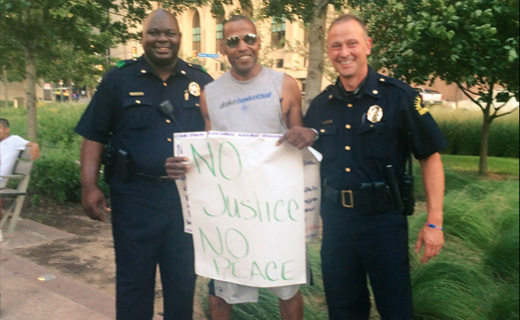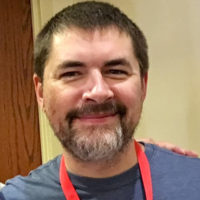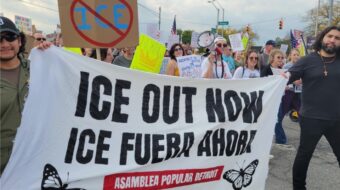
ST. LOUIS – These past few weeks have been a devastating time for both the African American community and for law enforcement.
It has been more than two weeks since the killing of Alton Sterling and Philando Castile, and more than a week since the shooting death of five Dallas police officers.
Tensions undoubtedly remain high as community activists, the Black Lives Matter movement and many trade unions navigate the dynamics of calling for justice and reform, while acknowledging the inherent difficulties and dangers associated with wearing a badge.
These tensions flared up here in St. Louis in an especially divisive and troubling way.
The morning after the Dallas killings Jeff Roorda, an ex-cop, former state representative and the current business manager of the St. Louis Police Officers’ Association (SLPOA), added fuel to the fire.
First, Roorda posted a photo to his Facebook page of two bloodied hands with the caption “Four Officers Dead In Dallas. THIS BLOOD IS ON YOUR HANDS, MR. PRESIDENT.” Then the SLPOA’s official Twitter page reposted Roorda’s post with the added comment, “I hope you’re happy @BarackObama.”
Not only were Roorda’s comments distasteful and untrue, they served to add pressure to an already strained relationship between St. Louis area police and the African American community.
It should be emphasized that Ferguson, Missouri – where Michael Brown was killed two years ago this August – is roughly thirty miles from St. Louis.
As if Roorda’s and the SLPOA’s actions weren’t harmful enough, they also called for the resignation of two sitting Alderpeople, Cara Spencer (Ward 20) and Antonio French (Ward 21), due to their support of the African American Police Officers’ Association, also known as Esop Genesis, and its vote of no confidence in Police Chief Sam Dotson.
The African American Police Officers’ Association, with about 220 members representing about 20 percent of the St. Louis police force, had issued a 112-page report accusing the chief of unfair disciplinary procedures, unfairly promoting white officers and prioritizing resources to the more affluent and white downtown area, while the predominantly Black north city neighborhoods were systematically under-resourced.
Esop Genesis is currently suing the city over its racist hiring and promotion practices.
Spencer and French publicly supported Esop Genesis’ report and the moderate reforms outlined therein. Spencer calmly suggested that the report “should be taken seriously.”
French questioned Roorda’s leadership and tweeted, “Jeff Roorda is not a St. Louis City cop. He does not live in St. Louis. @SLPOA should not let him speak for them.”
Shortly thereafter, the SLPOA issued the tweet, “We have asked for both you [Spencer] and @AntonioFrench to resign…I guess you don’t take your own words seriously.”
Spencer is a single mom and French is African American. Both represent constituents often at odds with the majority white male-dominated police force. And both have been vocal supporters of Black Lives Matter.
At a time when the police, the community and elected officials should be finding ways to work together, to build bridges geared towards a common approach to the very complex realities confronted by both the African American community and the police – especially African American police – it is unfortunate that the white male leadership of the SLPOA chose to be defensive and divisive, to attack the very people it should be reaching out to.
Like all unions, the SLPOA is not a hegemonic group. There are different political perspectives held by officers within the association, evidenced by Esop Genesis’ report.
Undoubtedly, Roorda does not speak for all St. Louis area police, especially African American police.
However, this social media melee has served to illustrate at least one important tactical question confronted by Black Lives Matter activists across the country – the need to work with police, especially African American police, in the struggle for justice and reform.
Arguably, neither justice nor reform is possible without dialog with the police, especially African American police and women officers.
From a tactical perspective, identifying fissure points within the police – emphasizing disparities between white and Black officers, for example, as a way to build unity with the Black Lives Matter movement – cannot and should not be ignored.
Demonstrating her willingness to build bridges and identify allies – within the police and within the community – Alderwoman Spencer earlier this week organized a “massive clean-up” in Gravois Park, one of Ward 20’s largest, most used public spaces. My former neighborhood.
“This is community policing at its best and I believe community policing is an essential component of crime prevention,” Spencer told the People’s World.
“Black Lives Matter,” she added. “And one of the best ways to protect Black lives is through community-police dialog and understanding. We have to build trust if we are going to end the cycle of violence.”
Whether out of embarrassment, internal or external pressure, the SLPOA has removed the offensive tweets.
Roorda, however, appeared on CNN the day after the Dallas killings claiming the Black Lives Matter movement was responsible for the deaths due to what he called “rhetoric that foments violence.”
There is currently a petition circulating on social media calling for the SLPOA to fire Roorda.
Bruce Franks, a state representative candidate in the 78th District covering much of downtown St. Louis, told the People’s World, “The POA has to meet ESOP at the table. If the POA can’t deal with racial disparities within the Department, how are they going to deal with disparities in the neighborhood?”
“That we even have two separate associations is a problem. We might as well still have separate water fountains,” Franks added.
Franks, who serves as the community liaison for ESOP and a volunteer instructor tasked with getting more people of color into the police department, isn’t a stranger to Black Lives Matter.
During the protests in Ferguson, Franks was assaulted by the police, receiving numerous lacerations and injuries. As a candidate, as a community leader and liaison, Franks knows first-hand the importance of looking for fissures within the Department that can build unity with Black Lives Matter.
In this trying time, however, Franks urged calm within the movement.
“Roorda is intentionally trying to get the community riled-up. He wants to be able to say, ‘Look at the good wholesome police. Look at what they have to deal with – these thugs and animals.’ We have to be calm and tactical in our fight for change,” he concluded.
“We have to build alliances – even with the police.”
Photo: Photo taken during the demonstration prior to the shooting of Dallas police officers indicates that demonstrators and police can cooperate. | Twitter/DallasPD










